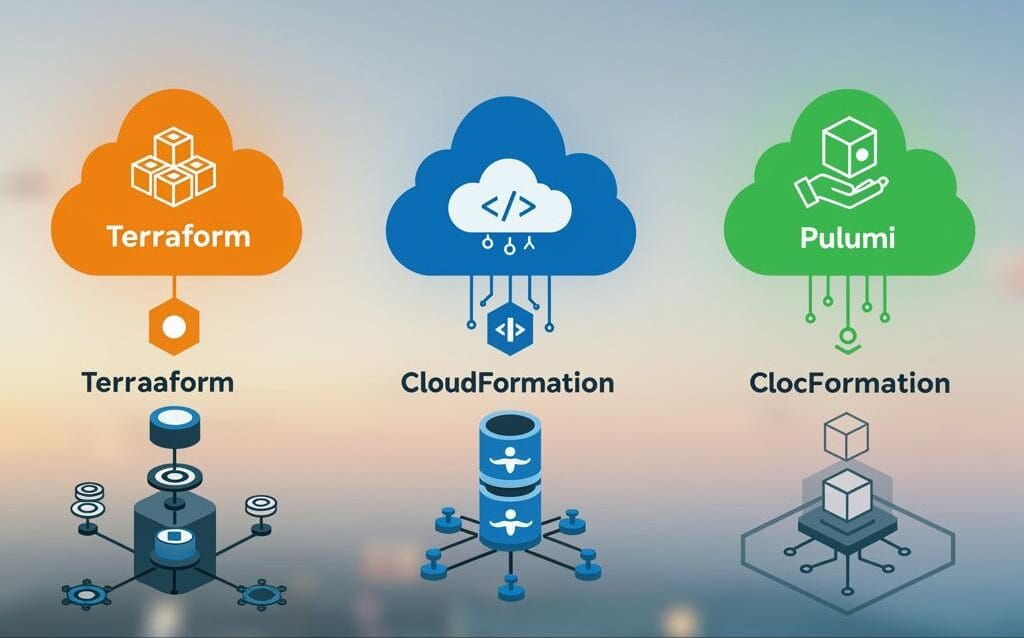Infrastructure as Code: Terraform, CloudFormation, Pulumi
Infrastructure as Code: Terraform vs. CloudFormation vs. Pulumi
Infrastructure as Code (IaC) is revolutionizing how we manage and provision infrastructure. Instead of manually configuring servers and networks, we can define our infrastructure using code, enabling automation, version control, and repeatability. This blog post compares three popular IaC tools: Terraform, CloudFormation, and Pulumi, to help you choose the best fit for your needs.
Terraform: The Platform-Agnostic Champion
Overview
Terraform, developed by HashiCorp, is an open-source IaC tool known for its platform-agnostic approach. It uses its own declarative language, HashiCorp Configuration Language (HCL), to define infrastructure. Terraform’s key strength lies in its ability to manage resources across multiple cloud providers (AWS, Azure, GCP, etc.) and even on-premises infrastructure.
Key Features
- Platform Agnostic: Supports a wide range of cloud providers and on-premises infrastructure.
- Declarative Configuration: Defines the desired state of infrastructure, and Terraform figures out how to achieve it.
- State Management: Tracks the current state of infrastructure, allowing for efficient updates and deletions.
- Extensible Provider Ecosystem: A large and active community develops and maintains providers for various services.
- Immutable Infrastructure: Promotes creating new infrastructure instead of modifying existing infrastructure, enhancing reliability.
Pros
- Multi-Cloud Support: Ideal for organizations using multiple cloud providers.
- Large Community and Ecosystem: Extensive documentation, tutorials, and community support available.
- Mature Tooling: Well-established and widely adopted in the industry.
Cons
- HCL Learning Curve: Requires learning a new configuration language.
- State Management Complexity: Requires careful management of the state file, especially in team environments.
- Limited Native Support for Some Cloud-Specific Features: May require custom scripting for advanced features.
CloudFormation: AWS’s Native Solution
Overview
CloudFormation is AWS’s native IaC service, tightly integrated with the AWS ecosystem. It allows you to define and provision AWS resources using templates written in YAML or JSON.
Key Features
- Native AWS Integration: Seamlessly integrates with all AWS services.
- Declarative Configuration: Defines the desired state of AWS resources.
- Rollback Capabilities: Automatically rolls back changes if a deployment fails.
- Change Sets: Allows you to preview changes before applying them.
- CloudFormation Registry: Provides a central repository for reusable resource definitions.
Pros
- Deep AWS Integration: Leverages all AWS features and updates immediately.
- No Third-Party Dependencies: Eliminates the need for external providers.
- Free to Use: You only pay for the AWS resources you provision.
Cons
- AWS-Specific: Limited to managing AWS resources only.
- YAML/JSON Verbosity: Templates can be verbose and difficult to read.
- Slower Deployment Times: Can be slower than Terraform for certain deployments.
Pulumi: IaC with General-Purpose Languages
Overview
Pulumi takes a different approach by allowing you to define infrastructure using familiar programming languages like Python, JavaScript, TypeScript, Go, and C#. This approach provides greater flexibility and expressiveness compared to HCL or YAML/JSON.
Key Features
- General-Purpose Language Support: Use familiar programming languages for infrastructure definition.
- Multi-Cloud Support: Supports multiple cloud providers, including AWS, Azure, and GCP.
- Strong Typing and IDE Support: Benefits from the features of the underlying programming language, such as type checking and code completion.
- Component Model: Enables the creation of reusable infrastructure components.
- Policy as Code: Allows you to define and enforce infrastructure policies using code.
Pros
- Increased Flexibility and Expressiveness: Leverage the power of programming languages for complex infrastructure logic.
- Improved Code Reusability: Create reusable components and modules.
- Enhanced Developer Experience: Use familiar tools and workflows.
Cons
- Steeper Learning Curve: Requires proficiency in a supported programming language.
- Potential for Abstraction Overload: Can be tempting to over-engineer infrastructure code.
- Relatively Newer Tool: Smaller community compared to Terraform and CloudFormation.
Choosing the Right Tool
The best IaC tool depends on your specific requirements and priorities. Consider the following factors:
- Cloud Provider(s): If you’re exclusively using AWS, CloudFormation is a strong contender. For multi-cloud environments, Terraform or Pulumi are better choices.
- Team Skillset: If your team is already proficient in a programming language like Python or JavaScript, Pulumi might be a good fit. If not, Terraform’s HCL may be easier to learn.
- Complexity of Infrastructure: For simple infrastructure, CloudFormation or Terraform might suffice. For complex, highly customized infrastructure, Pulumi’s flexibility can be beneficial.
- Community Support and Ecosystem: Terraform has the largest community and a mature ecosystem. CloudFormation benefits from AWS’s extensive documentation and support. Pulumi’s community is growing rapidly.
- State Management: All three tools require careful state management. Terraform’s state file requires extra attention.
Conclusion
Terraform, CloudFormation, and Pulumi are all powerful IaC tools with their own strengths and weaknesses. Terraform excels in multi-cloud environments, CloudFormation offers seamless AWS integration, and Pulumi provides the flexibility of general-purpose programming languages. Carefully evaluate your needs and priorities to choose the tool that best aligns with your organization’s goals and technical capabilities. Implementing IaC, regardless of the tool chosen, will significantly improve your infrastructure management practices, leading to greater efficiency, reliability, and scalability.

